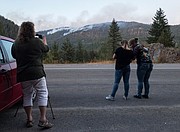WEST FORK AND MOOSE PEAK FIRES Relief after weekend winds milder than expected, yet cause for caution remains Firefighting resources still sought as both fires continue to grow
As wildfire smoke continued to dissipate from Libby skies Monday, a sense of relief filled the air in its place after worst-case-scenario, fire-fanning winds failed to materialize over the weekend.
To be sure, the West Fork and Moose Peak fires grew considerably -- the former to 13,372 acres, the latter to 8,209 acres -- and come Monday both remained active, zero-percent contained, sorely in need of resources and at times intense.
Yet some evacuations were lifted on schedule Sunday, and still no structures have been reported harmed or persons reported hurt.
“We were anticipating the worst and hoping for the best,” Lincoln County Emergency Management Planner and Libby Mayor Brent Teske said at a Sunday morning briefing. “I think we got the latter.”
“I think there was a lot of divine intervention in all this,” Lincoln County Commissioner Jerry Bennett said moments later.
But various officials were quick to acknowledge “we’re not out of the woods yet.”
A Red Flag warning was in effect Monday afternoon, indicating conditions were ripe for fire danger -- high temperatures and low relative humidity -- and Tuesday was “expected to be a near critical weather day with high winds and low relative humidity,” according to a Monday morning fact sheet released by incident command.
Sunday and Monday, crews assigned to the West Fork fire continued what officials have called a successful burnout operation near and along Forest Service Road 6144 that went down the west side to Quartz Creek Road.
Done ahead of the fire to the south, the burnout operation’s intent has been to clear and consume fuels to “seal off” the West Fork fire from populated areas to the south.
Residents evacuated from Bighorn Terrace and other nearby areas in advance of the burnout were allowed back Sunday beginning at noon and once again placed under pre-evacuation notice. Bobtail Road north of Hutton Drive and Bobtail Cutoff remained evacuated Monday.
Also on Monday, West Fork fire crews were assigned to create a fireline on the north and east sides of the fire by improving logging roads and dozer lines, while a dozer line from Bobtail Road to Pipe Creek was also improved as a containment line.
Four helicopters that fought the West Fork fire from the skies Sunday, dropping water near Forest Service Road 4613 as the fire grew eastward, were ready to work on Monday as well, but low visibility caused by smoke had kept them on the ground by Monday afternoon.
A large DC-10 air tanker was also employed Sunday to drop retardant north of Mount Tom “to slow fire growth and allow equipment and crews time to improve the primary containment lines near the junction of 17 Mile Road and Pipe Creek Road,” the fact sheet states.
Things got a little worrisome Sunday afternoon when a spot fire was discovered near Gold Hill about six miles east of Loon Lake -- outside the primary containment line -- but “two heavy air tankers were able to box the spot fire in with retardant,” according to the fact sheet.
The Moose Peak fire south of Libby was also active over the weekend, particularly near Miller Lake where on Sunday “crews burned out a section of unburned fuel along the dozer line extending north of the lake,” the fact sheet states.
The Moose Peak fire also had a spot fire develop outside the primary containment line, east of Fishtrap Creek, on Sunday, but “aerial resources quickly responded,” officials said.
Moose Creek fire crews were tasked Monday with monitoring the Miller Lake burnout and improving primary containment lines south of McGinnis Meadows from Fishtrap Creek. The Red Flag warning was also in effect in this area.
Evacuations remained in effect Monday for East Fisher Road and Bayhorse Ranch, while McGinnis Meadows remained under pre-evacuation notice.



